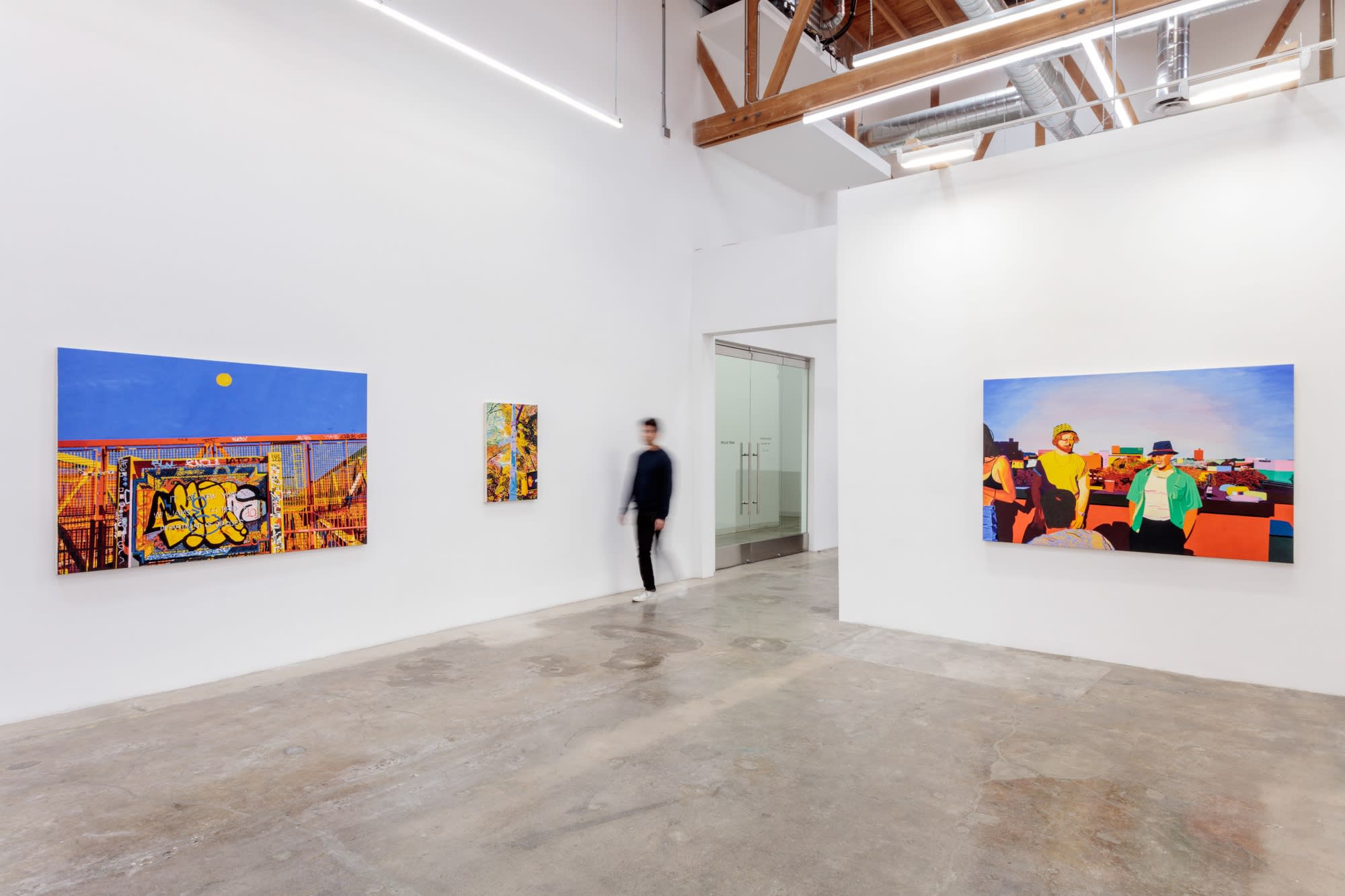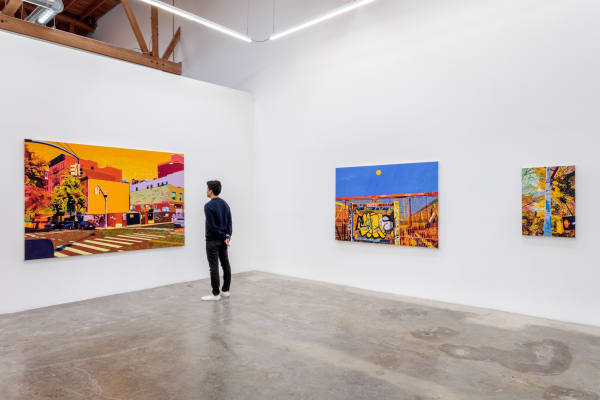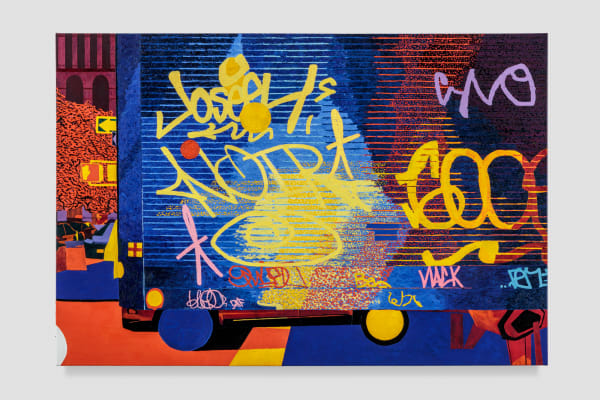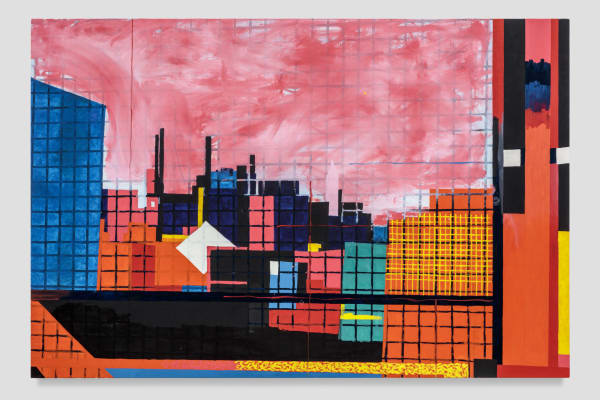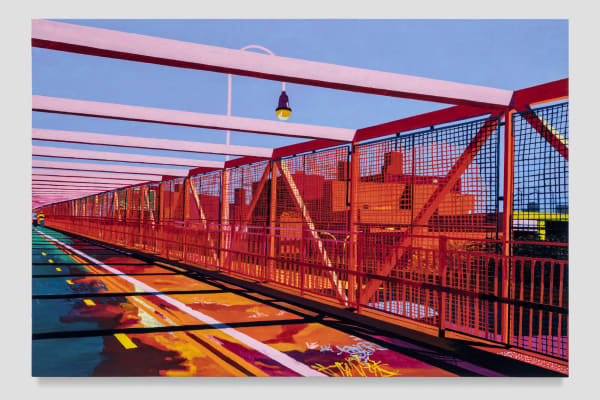Reuben Gordon: New Paintings
Baert Gallery is pleased to announce an exhibition of new paintings by the Los Angeles-based artist Reuben Gordon. This will be the artist’s first solo presentation at the gallery.
We will accomplish in the new world one hundred times more than we could in the old. But you’ll not be able to erase the old home from your heart. The heart will be drawn elsewhere. And in your solitude, images will rise up and stare in your faces.
— Abraham Cahan
It has in it all that you feel about Spain when you are there and all that you feel when you are away and cannot go there.
— Ernest Hemingway, on Joan Miro's The Farm.
Born and raised in the gritty bohemian milieu of Manhattan’s Lower East Side, Gordon applies virtuosically skillful finesse to paintings that feature scenes of daily urban life evocatively specific to, and imbued with, the spirit and ethos of their setting: overpass graffiti tags, billboards, and street signs, alongside stolen episodes of the day-to-day that capture the meaning of being young in the city: bar and apartment parties, sports games, dizzy car rides, and sneaky kisses. The paintings on view bring to mind the unvarnished intimacy of photographs by Nan Goldin and Wolfgang Tillmans, dealing, as they do, in fleeting and easily dismissed moments of youth and urbanity, and monumentalizing and historicizing those moments by bringing them into a conversation and a lineage with the convention of painting.
The exhibition features a comprehensive line-up of the artist’s key geographical touchpoints and modes of engaging the mnemonic dimension of creativity into the formal process of painting. This aspect is most readily evident in the selection from the Willy-B series, dedicated to New York’s Williamsburg Bridge, and featuring multiple views and perspectives of the landmark’s iconic gridded architecture. “I grew up by the Manhattan foot of the bridge, and many of my closest friends grew up near the Brooklyn foot of the bridge, so I spent a lot of time on it”, the artist remembers. Departing from this place profoundly imbued with association and reminiscence, these works irreversibly intersperse the abstraction of grid-based abstract painting and its expressionistic exploration of color with the very concrete pictorial basis at the root of their depictions.
Bridging the case between photorealism and expressionism, the crisp immediacy of line and palette characteristic of Gordon’s canvases belie the depth of meticulous technique and attention to detail that goes into the process of these works’ creation, rewarding intense contemplation and repeated viewing. The paintings begin their lives as film camera photos, spontaneously snapped by the artist at opportune moments of daily life. Back at the studio, they are fastidiously transferred onto canvas through a highly skilled and thoughtful technique that involves printing the original images and suspending them alongside empty canvas, then using precise measurement and mathematical calculations to replicate the foundational scenes in freehand and paint. With that original outline in place, the artist then departs from the point of direct reference and allows his own emotional state and personal narrative to dictate the coloring and the expressive gestures of the final paintings. In this way, his decisively contemporary scenes speak the language of Desus & Mero through the idiom of Arshile Gorky and Richard Estes.
Gordon’s recent move to Los Angeles is reflected in the renewed intensity of hue and a sense of abstraction characteristic of the freshest works on view. This relocation of the artist’s daily visual matrix from the muted urban density of New York City to the open vistas and sun-burned colors of Southern California has prompted Gordon to delve even deeper into the exploration of Manhattan’s (and occasionally Brooklyn’s) streets and characters. “The landscape of the Lower East Side, the East Village, and Brooklyn, and the fun-loving people I grew up with there”, he observes, “formed my internal architecture, as did the special kind of melancholy that exists in the desire for a colorful life.” Now removed from the immediate access to that setting, the artist has found a capacity for a renewed fervency of color and abstraction in which he bathes his latest landscapes. That is especially evident in 6th and C (Loisaida Ave), where the eerily deserted streets of a lower Manhattan intersection are suffused with a surrealistically expressive palette of ochres, lilacs, and mauves, creating a distinct impression of a place not located anywhere in the physical earthly context, but rather re-built, like a castle in the sky, through tricks of memory and powers of artistic expression. Likewise, in B and 10th (Charlie Parker Place), the autumnal colors of New York’s fall and the rusted grays of the city’s traffic light poles take on a near-phantasmagoric cadence of vivacity.
This dichotomy of presence and absence, of vision and recollection, embedded in all of the artist’s works, surfaces the tension between memory and immediacy. The brilliant, vividly saturated color scheme employed throughout the exhibition’s pieces is used knowingly, as both an expression of, and a reaching toward, the depth of affect and the emotional immediacy of a scene now remote, in an attempt to revivify it through the transformative magic of artistic expression. As Gordon himself has summed up this process, it is “trying to expel a nameless energy onto a canvas, in longing, hoping that your expressions relate to the universal, even though they come from an individual in solitude. This longing, and exteriorizing the unconscious, results in an anxious explosion of beauty that is objective and plastic at one and the same time”.
Reuben Gordon (b. 1996, New York, NY; lives and works in Los Angeles, CA) received his BFA from Bard College and has studied painting at the San Francisco Art Institute and The Art Students League of New York. His work is included in the permanent collections of the Frederick R Weisman Art Foundation, Los Angeles, CA; the Friends Seminary, New York, NY; and numerous private collections in New York, NY; London, UK; Rome, Italy; Los Angeles, CA; and Philadelphia, PA. He has participated in the solo and group exhibitions at Baert Gallery, the Wönzimer Gallery, Van Der Plas Gallery, the Tribeca Storefront, The Factory, Berlin, and The Painting Center, New York.
Join our mailing list
* denotes required fields
We will process the personal data you have supplied in accordance with our privacy policy (available on request). You can unsubscribe or change your preferences at any time by clicking the link in our emails.
